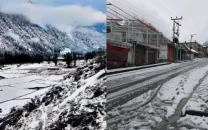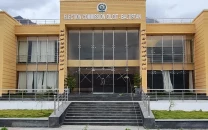Risky consumption: With contaminated water in Gilgit, disease can’t be far behind
Sedimentation and other impurities make water unfit for drinking or washing.

Though abundant in water resources, the melting snow peaks may signal alarm for residents of Gilgit city. Locals have to make do with water that has alarmingly high levels of turbidity in the absence of a filtration system.
Approximately 70,000 people are forced to use the contaminated water in the region. “I just don’t have words to describe the muddy and stinky water we are getting,” said Hammad Wali, a resident of Kashort area. He added that the water was unusable for both drinking and washing.
The level of turbidity in water has spiked up to near 60 Nephelometric Turbidity Unit (NTU) against a regular level of 5, a senior official at the Environment Protection Agency, Shehzad Shigri, told The Express Tribune on Tuesday.
While commenting on the causes of sedimentation, the official said that the melting snow and glaciers during summer erode the soil and flow it along to the reservoirs.
“Unfortunately, the Water and Sanitation Agency lacks any proper system to filter the water before supplying it to consumers,” he said. “We asked the concerned authorities to fix the problem or leave the task to someone else,” he said, adding that a proposal has been approved to install new safety tanks to purify the water.
Meanwhile, perturbed over the prevalent inflation, locals said they cannot afford to use filtration units to purge the water of impurities. Some are employing the traditional methods of using a piece of cloth to filter the water, which does not seem to work as the particles are too fine to be filtered. “We have tried but we can’t purge the water of dirt and stink. We are forced to drink it as it is,” said Aslam, another resident.
The sedimentation has not only made potable water hard to come by, but has resulted in blockage of water supplying pipes. A number of residents complained that they had to dig out their pipelines for cleansing as the mud mixed in with water chokes the pipelines.
A public health specialist, Dr Feroz Khan, said that the contaminated water poses a threat of waterborne diseases, adding that the number of patients with gastro-intestinal tract infections has increased in local hospitals. Besides Kashort, other areas suffering from the crisis include Jutial, Nagral, Majini Muhalla, Khomer, Hospital road, Domiyal, Amphery, and Zulfiqarabab.
Published In The Express Tribune, June 20th, 2012.


















COMMENTS
Comments are moderated and generally will be posted if they are on-topic and not abusive.
For more information, please see our Comments FAQ